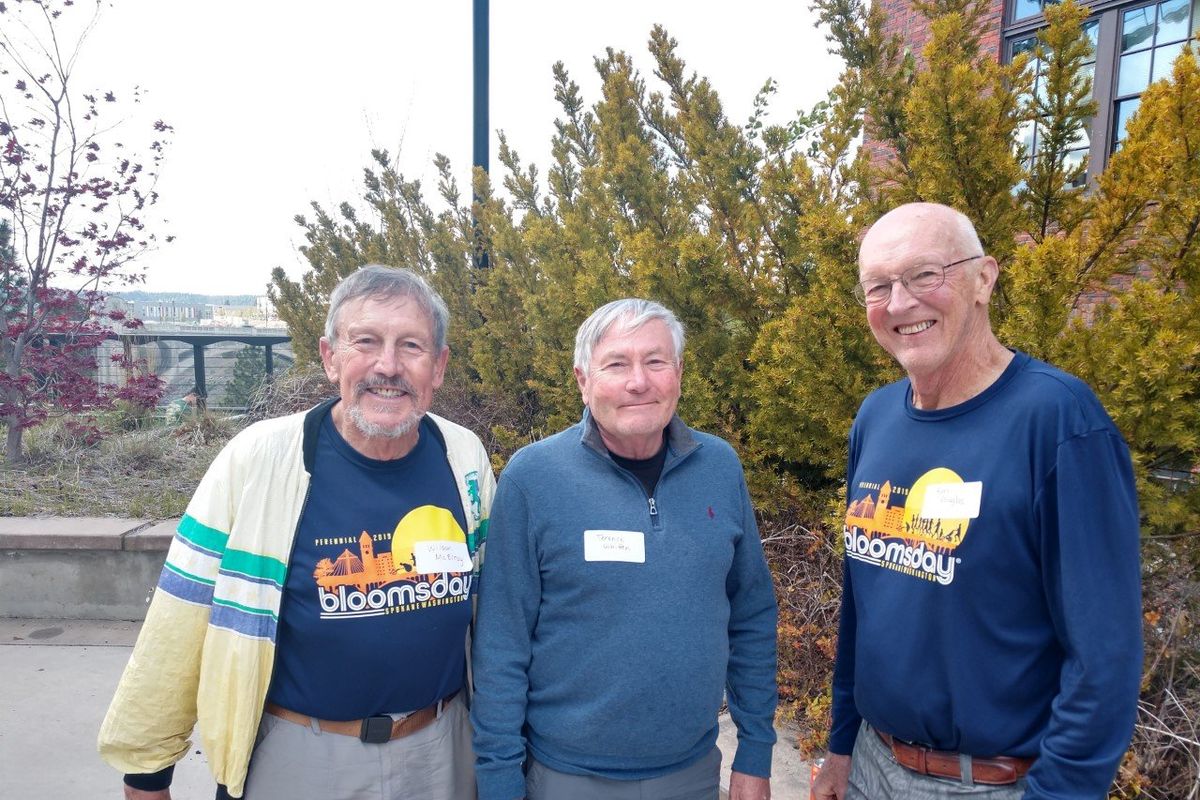Basketball to Bloomsday: How a pickup basketball game turned into more than four decades of races

In the mid-1970s, three young professionals became members of the Spokane Club and started playing a pickup basketball game a few nights a week. Little did they know, the game would turn into a decadeslong connection to each other, the Spokane community and running.
Terry Whitten, Ron Douglas and Bill McElroy forged a friendship as regulars on the basketball court. One day, McElroy’s stepson, Tom Taylor, told the group about a new race his track coach was promoting called Bloomsday.
The young boy was excited about the race and asked the trio if they would run.
“That sounds like the dumbest thing I’ve ever heard,” McElroy remembers saying.
But Douglas and Whitten were on board, and McElroy didn’t want to be the odd man out, so the group began training for the race just a few weeks out.
On May 1, 1977, the men pulled on their Converse basketball shoes and got running.
“Of course, I was really slow,” McElroy said. “What was amazing is I thought I’d be in the same company as far as runners around me but everybody was fast and I wasn’t.”
The other two basketballers thought the same.
“Bill and Terry and I thought that because we can run up and down a basketball course that we could certainly run 7 miles without a problem,” Douglas said with a chuckle. “By the end of the race, I was no longer running, I was walking.”
The group’s feet hurt and they were slow, but they all finished the race.
“We all made it, and we didn’t get hurt,” Whitten said.
Despite the grueling first race, all three men quickly became hooked on running.
“I’d always run a little bit, but not much,” Whitten said. “Running became a more significant part of my life.”
“I like a challenge,” Douglas said. “I realized very quickly that my basketball two or three evenings a week wasn’t putting me in as good of condition physically as I thought it was.”
He started running five or six days a week.
“I was hooked,” Douglas said.
McElroy “got a kick” out of the first race and also started running consistently, training seven days a week in the 1980s.
As the men got faster, more people starting joining in on the annual Bloomsday run.
“I never really thought about having a streak. It just sort of happened one year at a time,” McElroy said. “It turned into a passion. It’s a victory in your life when you run a Bloomsday 45 times.”
All three men are Bloomsday perennials, having completed every race, even during the last two years of the COVID-19 pandemic when the race was held virtually.
This year, about 80 such perennials are expected to complete Bloomsday either virtually or in person, said Jon Neill, Lilac Bloomsday race director.
“There certainly is kind of an intangible bond or camaraderie between us all,” Whitten said of the perennials.
After 45 years and a global pandemic, each of the three men have taken their own approach to the return of the iconic race.
Generations of Bloomies
For Whitten, 76, the race has turned into a family affair. His son, Ty Whitten, became a good runner at University High School and continued his running career at the University of Washington.
His daughter, Leslie Robinson, also joined in on the Bloomsday fun and has completed about 30 Bloomsdays, Whitten estimates.
And this year, Whitten’s 11-year-old grandson, Josh Robinson, is going to tackle his first Bloomsday.
“It makes me feel very good to see my family getting enjoyment out of running like I have,” Whitten said.
This year, Whitten plans to walk the course with the rest of the Bloomsday crowd.
Run your own way
The last two years of pandemic races provided Douglas, 76, with new Bloomsday experiences.
In 2020, he was “hiding out” at Schweitzer Mountain with his wife during the initial pandemic lockdown. The pair did their virtual Bloomsday at the city park in Sandpoint, which he acknowledges doesn’t have a Doomsday Hill.
Last year, the pair started the race from their home on the Bloomsday course.
“We started at home and did the course and finished back at home,” Douglas said. “It was nice of Bloomsday to have the virtual run.”
His family got in on the virtual runs too. Douglas’ daughter, Alison Douglas, lives in Paris and completed a virtual Bloomsday there.
With continued COVID concerns, Douglas used the virtual option to complete his Bloomsday Friday afternoon with another perennial friend, Bill Peters.
He plans to watch the race from his front door on Sunday.
“We live right on the course; all we have to do is walk out our front door,” he said with a chuckle.
Ending the tradition ‘on my terms’
During the pandemic, McElroy, 75, walked daily for “something to do,” since it was one of the only COVID-safe activities.
He completed both virtual runs and enjoyed the “pick your own course” aspect, he said.
This year, though, McElroy is hanging up his walking shoes after a knee replacement and back problems.
“I’m not going to do it because I finally have exhausted my back,” McElroy said. “I just can’t do it.”
While some people continue completing the race in a wheelchair, McElroy wanted his streak to end his way.
“I want my Bloomsday to be on my terms and to be done well,” he said.
Calling it quits is going to be hard, McElroy said, but after 45 years, it’s time.
“I’m hoping that Terry (Whitten) and Ron (Douglas) make it to 50,” McElroy said.
After four decades, thousands of miles run and lots of life changes, one thing has stayed the same for the three men.
“We’re still friends and we still belong to the Spokane Club,” McElroy said, with a laugh.